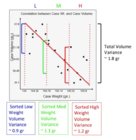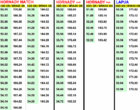the valid point is that in real life the small difference is less than noise in the real numbers we deal with.
we deal in .01 or .02 grains, NOT IN .00X.
we deal in .01 or .02 grains, NOT IN .00X.
I think you might be misunderstanding the point about the scale precision?
Measuring with grains, the FX120 is only capable of 0.02 grain precision, meaning it can read 0.00, 0.02, 0.04, etc.
Measuring in grams, it has 0.001 gram precision, meaning it can read 0.000, 0.001, 0.002, etc.
0.02 grains = 0.001296 grams
0.001 grams = 0.0015432 grains
It uses grams (metric) as the base measurement, then converts for the display. The display is limited, so the scale has to round up.
If I measure in grams and covert to grains, I can maintain some precision because I'm not forced to round as much:
0.001 g = 0.0015 gr
0.002 g = 0.0031 gr
0.003 g = 0.0046 gr
Conversely, if I measure in grains on the scale and wanted to convert to grams, I lose precision:
0.002 gr = 0.0013 g
0.004 gr = 0.0026 g
0.006 gr = 0.0039 g
This only matters when trying to measure really small differences and the effects aren't cumulative (it seems like you are assuming that's what we're saying).
I disagree entirely that it's a waste of time. I learned quite a bit from this experiment and I think you could as well.
Frankly, your comments are coming across as rather rude.
It took over 100 hours to do this research, pour over the data, and write it up to share with the world. How long you spend taking a dump on my work? If you'd like to prove something, then put in the same amount of effort and show your work.













